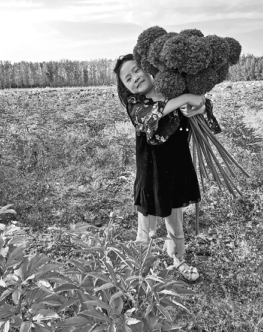A blossoming career
Peony expert sees his love of the plant spread across a number of fields, Xu Fan reports.

More than 20 years ago, Fan Baoxing-then a master's student at Shandong Agricultural University-was focusing on researching male and female flowers of cucumbers to raise the annual yield. However, a sudden task assigned by his tutor altered his life path.
"My tutor received a project aimed to extend the peony flowering span entrusted from the Shandong Science and Technology Commission. As the task required spending a lot of time in the field, and I was the only male of my teacher's three students, he suggested I suspend cucumber research and conduct the peony project first," recalls Fan.
In April 1996, Fan traveled to the project's cooperating site-Caozhou Peony Garden in Heze in western Shandong province, one of the world's largest peony nurseries which is home to over 1,200 varieties of 800,000 peony plants.
With the fading daylight distributing itself over the vast garden, the flowers were tinted with the sunset's color, forming an outrageously beautiful sight that Fan says he would never forget for the rest of his life. Despite being tired after the trip, Fan didn't take a rest. Instead, he walked throughout the garden to immerse himself in the fragrant flowers.
"The view was gorgeously appealing. A thought popped into my mind that I wanted to make more people admire such a wonderful sight," he says.
Since then, Fan-who was born in Shandong's Chiping county in 1973-has completely shifted to the cultivation and caring of peonies, with his decades-long passion devoted to a wide array of peony-related events, from developing new species to organizing exhibitions and hosting tutoring programs.
Depicted by the China Flower and Gardening News as "a pioneer in China's peony garden construction", Fan has been in charge or participated in a number of such projects. These have ranged from assisting countries like the Netherlands and France to build Chinese-style peony gardens to helping more than 20 cities, including Taixing in Jiangsu and Jiangyou in Sichuan, to construct local peony parks.
"China has a long and storied history of growing peonies. Almost synonymous with giant pandas and the Great Wall, peony flowers have been considered an icon to symbolize China in some sense," he says.
With their fluffy blooms and vibrant colors ranging from purple to pink, peony flowers are deemed a symbol of prosperity and noble status. For several dynasties they were only allowed to be grown in royal gardens, according to Fan.
Tang Dynasty (618-907) poet Liu Yuxi's wrote a poem praising their appeal:"Only the peony is qualified to be hailed as the national beauty. It has a sensational charm to captivate the entire capital when it blooms".
Citing the lines to exemplify their popularity in ancient China, Fan says more than 10,000 poems were written featuring peony flowers in the Tang Dynasty.
"Peony flowers not only inspire literary creations, but also spawn a lot of other cultural works and daily utensils. Such an influence can still be seen today, with the flowers used as patterns on costumes or furniture," he adds.
Most people would feel happy and relaxed admiring a sea of peony blossom, but few of us probably know the difficulty of transporting these tender and delicate plants. After investing a lot of time and his own saving, Fan has become an expert on "escorting" peony flowers safely to their destinations during long trips.
One of his most impressive moments came in 2016, when the Palace Museum in Beijing, also known as the Forbidden City, held a floral exhibition to display more than 12,000 potted peonies transported from Luoyang in Henan province, itself known for its annual peony festival.
Serving as the head in charge of the exhibition, Fan had resided in the Forbidden City for 18 days, as his work-guiding workers to display pots and caring the blooming flowers-could only be conducted in the early morning or after dusk, before or after the palaces opened or closed to tourists.
When all the lamps in the palaces were extinguished, casting a soft light over the lanes lined with peonies in bloom, Fan says he felt he was one of a few fortunate people who could see the Forbidden City showcasing its distinctive beauty. In appreciation of his efforts, Shan Jixiang-the then director of the Palace Museum-treated Fan to a royalstyle dinner.
One year after he earned recognition for holding large-scale peony events, Fan was entrusted by the Beijing Municipal Forestry and Parks Bureau to transport and display 2,600 pots of peony flowers on the Tian'anmen Square. This was a floral treat to guests attending the Belt and Road Forum for International Cooperation in 2017.
Describing it as a challenging mission, Fan recalls he was notified to provide the peony flowers in late April near the end of their flowering cycles. Digging out thousands of roots from a plantation base in Shandong province, Fan hired more than 10 trucks to transport them to a greenhouse on the outskirts of Beijing. This gave two days to allow the plants to adjust to the new temperature, before reloading them to Tian'anmen Square.
Fan-who launched his own peony garden in 2016 in Beijing's Shunyi district-has also become a veteran expert on peonies. He obtained a doctorate by majoring on the medicinal values of peonies at the Academy of Military Medical Sciences, publishing more than 50 papers and a book, with the latter exploring the economic prospects of woody and herbal peony species.
"Every part of a peony plant is useful. Aside from the freshly cut flowers for decoration, the volatile components extracted from the plants could treat depression. Peony flowers can also be made into tea and food," he says.
With his passion of the flowers, Fan has set an ambitious goal to turn his Beijing garden into an attraction to gather both tourists and peony enthusiasts, as well as helping different cities in China to build a total of 100 peony gardens.
However, Fan's own garden has seen a drastic drop of visitors due to the pandemic resurgence in Beijing, unfortunately in line with the blooming period. "I dug a cellar to store cut flowers as the low temperature benefits an extended bloom. Besides, we have also worked hard to sell the flowers and potted roots via e-commerce platforms," says Fan.
"Some of my friends and customers have sent me photos, recording that how they used the petals of peony flowers as ingredients to cook various dishes, like pork-ribbed soup, seafood salad, porridge, noodles and dumplings," says Fan.
"Peonies have been used as food for centuries. If all the processed foods are included, there could be a total of more than 400 cooking and processing methods of eating peonies," he adds.
Noting that tulips are a pivotal industry in the Netherlands, Fan says he hopes the importance of peonies could be more recognized, wishing the beautiful plants could exert more influence to propel China's gardening industry as well as serving as a medium to boost international exchanges.

































